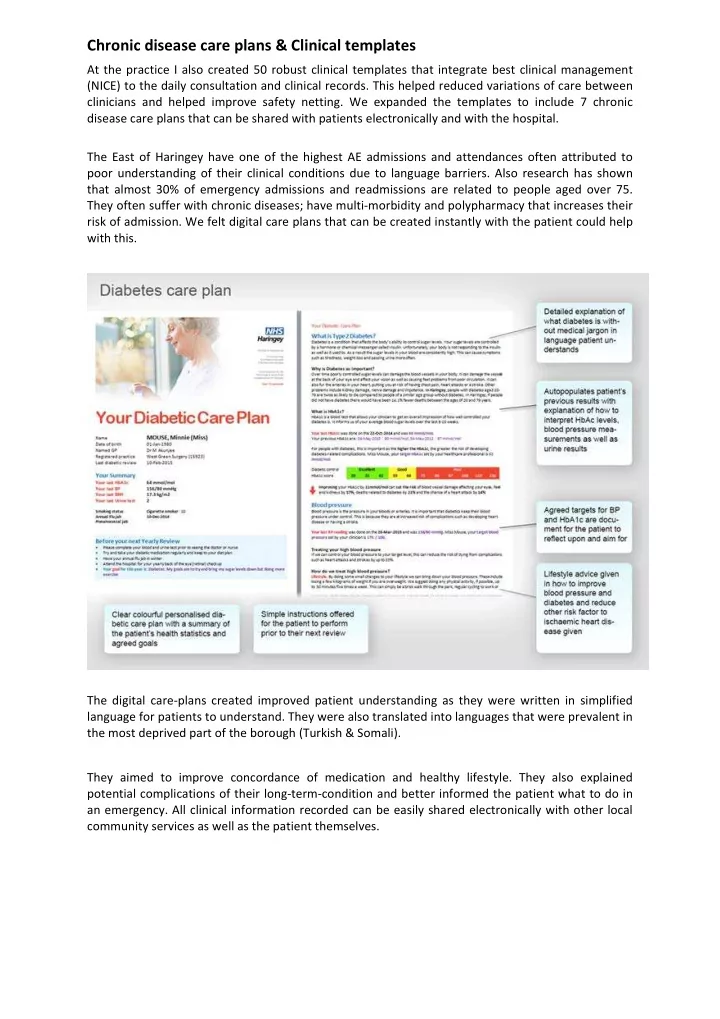

Chronic disease care plans & Clinical templates At the practice I also created 50 robust clinical templates that integrate best clinical management (NICE) to the daily consultation and clinical records. This helped reduced variations of care between clinicians and helped improve safety netting. We expanded the templates to include 7 chronic disease care plans that can be shared with patients electronically and with the hospital. The East of Haringey have one of the highest AE admissions and attendances often attributed to poor understanding of their clinical conditions due to language barriers. Also research has shown that almost 30% of emergency admissions and readmissions are related to people aged over 75. They often suffer with chronic diseases; have multi-morbidity and polypharmacy that increases their risk of admission. We felt digital care plans that can be created instantly with the patient could help with this. The digital care-plans created improved patient understanding as they were written in simplified language for patients to understand. They were also translated into languages that were prevalent in the most deprived part of the borough (Turkish & Somali). They aimed to improve concordance of medication and healthy lifestyle. They also explained potential complications of their long-term-condition and better informed the patient what to do in an emergency. All clinical information recorded can be easily shared electronically with other local community services as well as the patient themselves.
The care plans would auto-populated the patient’s most uptodate clinical records (medical problems, allergies, blood tests, BMI, smoking status) providing a live record. Since this is automated, this would significantly save health professional’s time from writing out such information and reduce risk of errors. The care plans also included a section that allowed personalised goal setting. It was used to outline the patient’s agreed goals for that year of care and establish how important it is for the patient to achieve them. The final element of the care plan included a summary of the agreed steps with the health clinician during their consultation.
They also helped educate appropriate health seeking behaviour and awareness of red flag symptoms as it included emergency care-plan and instructions of what to look out for. We feel this has led to reduced A&E attendances, secondary care admissions, medication wastage and improved patient satisfaction. We also developed corresponding EMIS web templates that incorporated local management pathways for gold standard diagnoses and management as well as contact details for services that
might be useful such as social services numbers, community matrons as well as district nurse phone numbers. This helped to collate all the relevant information available in one neat place for all health professionals working at the surgery to access. Each Clinical template included information around; how to make the clinical diagnosis according to national guidance [NICE, BTS, SIGN], evidence based management strategies according to local and national guidance, treatment recommendations based upon local CCG pharmacy formularies and relevant local referral pathways and contact details. This permitted standardisation of care between clinicians with management, diagnosing and referring of patients, resulting in better outcomes for patients We carried out early analysis at our surgery of the diabetic care-plan that showed that when 31 patients had a detailed consultation with the care plans identifying personal goals and agreements of shared outcomes, there was a reduction of their Hba1c by 1.563mmol/mol post intervention (from 57.375 to 55.812). There was no cost involved in making the templates in English and minimal costs in translating them into additional languages. Due to the low costs associated with the project, the care plans can easily be distributed into other practices, federations or at scale across CCGs as well as community based specialist clinics using similar computer systems EMIS (most widely used GP system) or Vision. The care plans have already been shared with 20 practices in the more deprived region of Haringey where English was not the first language and where the highest AE attendances and admissions from LTC was noted. GPs and health professionals who have been using it have expressed great positivity and now there is plan to share with the rest of Haringey (40+ practices) benefiting 267,000 patients. It received support from Haringey CCG diabetic lead as well as the Assistant Director of Primary Care Haringey CCG ‘The Diabetes Over 74 Care Plans is a visual template that is easy for both GPs/nurses and patients to understand. It clearly states ideal targets, although these can be changed depending on how tightly their diabetes should be managed. Targets can also change when they have their review or if new medications have been initiated. There is a short section on contact details for secondary/intermediate care which is useful for both the clinician and the patient. Having used the template, I feel that patients get a more personalised management of their diabetes. With clear targets, it may help to motivate patients to understand what their targets are, and to improve their diabetic control. ‘ Dr Daijun Tan, GP, Clinical Lead for Diabetes Haringey CCG Supported by Haringey CCG ‘We were very impressed with this innovation and believe that it is a simple and powerful tool for improving patient care in relation to diabetes. It enables people to have a clear and personalised care plan for managing their condition in full colour and is fully integrated into the patient’s electronic record. The care plan has been rolled out across practices in the east of the borough and is now therefore being used with patients of 23 practices which means that the impact has been broad. ...’ Cassie Williams, Assistant Director of Primary Care, Haringey Clinical Commissioning Group (CCG)
Recommend
More recommend